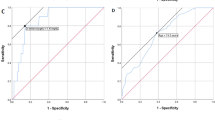Abstract
Objective
To investigate risk factors for perioperative death in elderly patients with intertrochanteric fracture.
Methods
Clinical data from 1051 cases with intertrochanteric fracture from March 2005 to March 2015 were reviewed and analyzed, and causes of death during the perioperative period were statistically analyzed. Various indicators were compared by t test and χ2 test. Multivariate analysis was performed using non-conditional logistic regression analysis.
Results
Chronic diseases of major organs (heart, brain, and lung), postoperative complications, and various indicators within 24 h after admission (albumin, hemoglobin, brain natriuretic peptide [BNP], glucose, creatinine, arterial blood pH, PaO2, and APACHE II) were statistically significantly different between patients who survived and those who died. Logistic regression analysis indicated that postoperative complications, APACHE II score, BNP, and chronic diseases of major organs were the risk factors for perioperative mortality in elderly patients with intertrochanteric fracture.
Conclusion
BNP and APACHE II score could be used as important reference indexes for predicting possible perioperative mortality in elderly patients with intertrochanteric fracture and chronic diseases of major organs. Complications after fracture may be also risk factors.
Similar content being viewed by others
References
Abdelkhalek M, Ali AM, Abdelwahab M (2013) Cemented bipolar hemiarthroplasty with a cerclage cable technique for unstable intertrochanteric hip fractures in elderly patients. Eur J Orthop Surg Traumatol 23(4):443–448
Ha YC, Park YG, Nam KW et al (2015) Trend in hip fracture incidence and mortality in Korea: a prospective cohort study from 2002 to 2011. J Korean Med Sci 30(4):483–488
Kesmezacar H, Ayhan E, Unlu MC et al (2010) Predictors of mortality in elderly patients with an intertrochanteric or a femoral neck fracture. J Trauma 68(1):153–158
Bilsel K, Erdil M, Gulabi D et al (2013) Factors affecting mortality after hip fracture surgery: a retrospective analysis of 578 patients. Eur J Orthop Surg Traumatol 23(8):895–900
Pean CA, Goch A, Christiano A et al (2015) Current practices regarding perioperative management of patients with fracture on antiplatelet therapy: a survey of orthopedic surgeons. Geriatr Orthop Surg Rehabil 6(4):289–294
Simunovic N, Deveraux PJ, Sprague S et al (2010) Effect of early surgery after hip fracture on mortality and complications: systematic review and meta-analysis. CMAJ 182(15):1609–1616
Shi L, Wang XC, Wang YS (2013) Artificial neural network models for predicting 1-year mortality in elderly patients with intertrochanteric fractures in China. Braz J Med Biol Res 46(11):993–999
Zhao P, Lian X, Dou X (2015) Intertrochanteric hip fracture surgery in Chinese: risk factors for predicting mortality. Int J Clin Exp Med 8(2):2789–2793
Smektala R, Endres HG, Dasch B (2008) The effect of time to surgery on outcome in elderly patients with proximal femoral fractures. BMC Musculoskelet Disord 9(1):171
Bateman L, Vuppala S, Porada P et al (2012) Medical management in the acute hip fracture patient: a comprehensive review for the internist. Ochsner J 12(2):101–110
Ferré F, Minville V (2011) Preoperative management to reduce morbidity and mortality of hip fracture. Ann Fr Anesth Reanim 30(10):e45–e48
Taniguchi D, Fujiwara H, Kobashi H et al (2013) Successful treatment of concomitant ipsilateral intracapsular and extracapsular hip fractures. Orthopedics 36(6):837–839
Su H, Liu H, Liu J et al (2018) Elderly patients with intertrochanteric fractures after intramedullary fixation: analysis of risk factors for calf muscular vein thrombosis. Orthopade 47(4):341–346
Kara K, Gronewold J, Neumann T et al (2014) B-type natriuretic peptide predicts stroke of presumable cardioembolic origin in addition to coronary artery calcification. Eur J Neurol 21(6):914–921
Myoren T, Kobayashi S, Oda S et al (2016) An oxidative stress biomarker, urinary 8-hydroxy-2′-deoxyguanosine, predicts cardiovascular-related death after steroid therapy for patients with active cardiac sarcoidosis. Int J Cardiol 212:206–213
Garcea G, Ganga R, Neal CP et al (2010) Preoperative early warning scores can predict in-hospital mortality and critical care admission following emergency surgery. J Surg Res 159(2):729–734
Author information
Authors and Affiliations
Corresponding author
Ethics declarations
Conflict of interest
The authors declare that we have no conflict of interest.
Rights and permissions
About this article
Cite this article
Zhao, F., Wang, X., Dou, Y. et al. Analysis of risk factors for perioperative mortality in elderly patients with intertrochanteric fracture. Eur J Orthop Surg Traumatol 29, 59–63 (2019). https://doi.org/10.1007/s00590-018-2285-9
Received:
Accepted:
Published:
Issue Date:
DOI: https://doi.org/10.1007/s00590-018-2285-9




